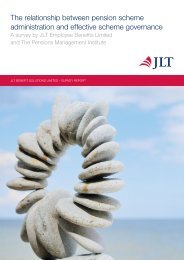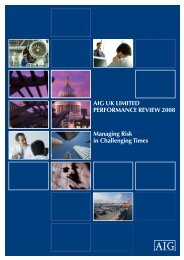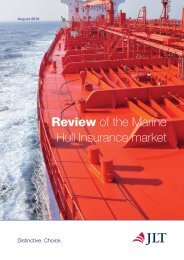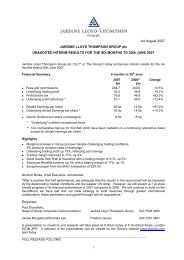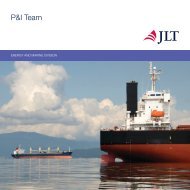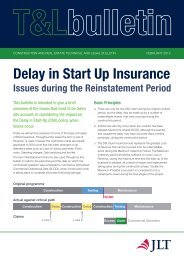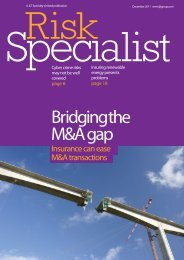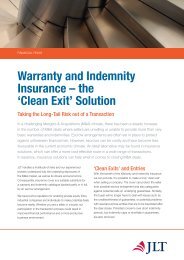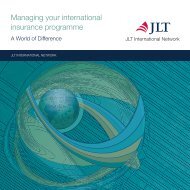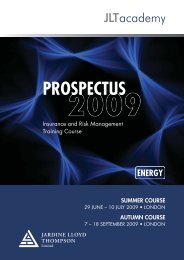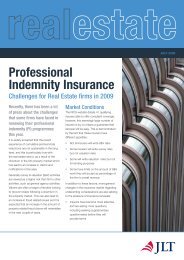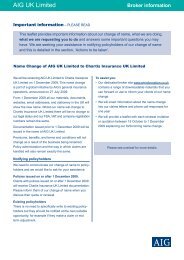Report & Accounts - JLT
Report & Accounts - JLT
Report & Accounts - JLT
- No tags were found...
Create successful ePaper yourself
Turn your PDF publications into a flip-book with our unique Google optimized e-Paper software.
Full actuarial valuations of the Group’s main defined benefit schemes are carried out at least every three years. A qualifiedindependent actuary updates these valuations to 31st December each year. For the purposes of these annual updates, schemeassets are included at market value and scheme liabilities are measured on an actuarial basis using the projected unit method;these liabilities are discounted at the current rate of return on an AA corporate bond of equivalent currency and term. The definedbenefit surplus or deficit is included on the Group’s balance sheet. Surpluses are included only to the extent that they arerecoverable through reduced contributions in the future or through refunds from the schemes. The current service cost and anypast service costs are included in the income statement within salaries and associated expenses and the expected return on theschemes’ assets, net of the impact of the unwinding of the discount on scheme liabilities, is included within finance costs. Actuarialgains and losses, including differences between the expected and actual return on scheme assets, are recognised through theStatement of Recognised Income and Expense.A defined contribution plan is a pension plan under which the Group pays fixed contributions into a separate entity. The Group hasno legal or constructive obligations to pay further contributions if the fund does not hold sufficient assets to pay all employees thebenefits relating to employee service in the current and prior periods.The costs of the Group’s defined contribution pension schemes are charged to the income statement in the period in which theyfall due.Share-based compensationThe Group operates a number of equity-settled, share-based compensation plans. The fair value of the employee services receivedin exchange for the grant of the options is recognised as an expense. The total amount to be expensed over the vesting period isdetermined by reference to the fair value of the options granted, excluding the impact of any non-market vesting conditions (forexample, profitability and revenue growth targets). Non-market vesting conditions are included in assumptions about the number ofoptions that are expected to become exercisable. At each balance sheet date, the entity revises its estimates of the number ofoptions that are expected to become exercisable. It recognises the impact of the revision of original estimates, if any, in the incomestatement, and a corresponding adjustment to equity over the remaining vesting period. The proceeds received net of any directlyattributable transaction costs are credited to share capital (nominal value) and share premium when the options are exercised.Provisions for liabilities and chargesThe Group discounts certain provisions to their present value. The unwinding of the provision discounting is included as an “interestcharge” within finance costs in the income statement.A provision is recognised where there is a present obligation, whether legal or constructive, as a result of a past event for which it isprobable that a transfer of economic benefits will be required to settle the obligation and a reasonable estimate can be made of theamount of the obligation.Fees and commissionsFees and commissions are derived from two principal sources:Insurance brokingIncome relating to insurance broking is brought into account at the later of, the policy inception date or when the policy placementhas been completed and confirmed. Where there is an expectation of future servicing requirements an element of income relatingto the policy is deferred to cover the associated contractual obligation.Other servicesFees and other income receivable are recognised in the period to which they relate and when they can be measured withreasonable certainty.Non-recurring itemsItems of a non-recurring and material nature are charged or credited to operating profit and are classified to the appropriate incomestatement headings. To assist in the analysis and understanding of the underlying trading position of the Group these items aresummarised within the Operating Profit, note 4 on page 64, under the heading of “exceptional items”.Leased assetsAssets held under leasing agreements, which transfer substantially all the risks and rewards of ownership to the Group are includedin property, plant and equipment. The capital elements of the related lease obligations are included in liabilities. The interestelements of the lease obligations are charged to the income statement over the period of the lease term.Leases in which a significant portion of the risks and rewards of ownership are retained by the lessor are classified as operatingleases. Payments made under operating leases (net of any incentives received from the lessor) are charged to the incomestatement on a straight-line basis over the period of the lease.Financial Statements Jardine Lloyd Thompson Group plc Annual <strong>Report</strong> & <strong>Accounts</strong> 200555



